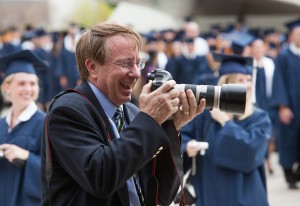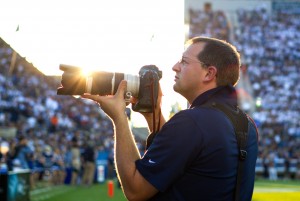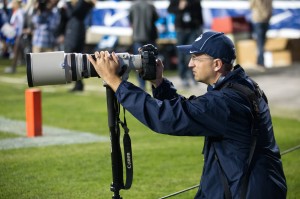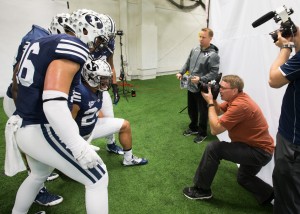Tell a story of 1,000 words in less than a second. Tell a story that will go viral in less than a minute. Tell a story that is of such quality and emotion, it will be remembered for hundreds of years. This is the task of BYU photographers Mark Philbrick and Jaren Wilkey, who consistently succeed and surpass expectations.

These two, along with a staff of seven student photographers, are, as Philbrick said, the “visual historians” of the university.
“Our role here at the university is to take care of the visual imagery of the university, to show the world what BYU is like through our pictures,” Wilkey said.
BYU didn’t have a full-time university photographer until 1976. Philbrick was the first person appointed to this position and he has built a photography dynasty at BYU. Philbrick was honored at the football game on Saturday, Nov. 21 for his contribution to the university. He plans to retire in 2016.
Philbrick’s dynasty has become respected across the nation as one of the best. The University Photographers Association of America president Glenn Carpenter used words such as “anomaly” and “incredible talent” to describe Philbrick and Wilkey.
Photography in 1976 was completely different than it is today. An obvious difference is that film cameras were used. Sometimes Philbrick would shoot in black and white and other times in color. Philbrick said a roll of film could hold 36 photos and shooting a sports event could cost several hundred dollars in film and developing. The time it took to even get the first glance at the shots was a key drawback to film.
“When you shot film, you would have to wait through the weekend — Monday or Tuesday — before you processed it,” Philbrick said.
However, Philbrick said the photos that he took were largely for posters or publications down the road.
This all changed with the advent of digital photography. Philbrick said he took 360 photos in the last gymnastics meet he shot before moving to digital cameras. He shot 1,800 pictures in the first meet with a digital camera.

“Before, when you shot with film, you were very hesitant. You went for the safe shots, the shots you knew you could get,” Philbrick said. “As soon as we moved to digital, you were able to be a lot more creative, and were able to try a lot more things and get some better timings and positioning. It was eye opening.”
Wilkey played a key part in helping BYU become one of the first universities in the nation to transition to digital photography — a transition Wilkey said “completely changed what (we) do in this office and how (we) portray the university in a visual way.”
It became easier to place pictures on websites, and more departments needed photographic support. Philbrick and Wilkey have seen their responsibilities largely expand and have taken the growth and the technological changes in stride.
“You must be adaptable. Adapt or die,” Wilkey said. “The university has needed different things from us over the years, so we’ve kind of evolved with those needs.”
Philbrick said he views these changes as an opportunity rather a challenge. He and Wilkey accept any proposal that comes their way and learn how to do things they didn’t know before. This philosophy has helped them become more than just relevant in what they do, it has helped them become the best in their field.
Philbrick said BYU is now are one of the leading universities in what it does. Nowhere is BYU’s forefront position better seen than in the development of a cutting-edge system to wirelessly send photos at live events.
“Basically, our cameras have a wireless attachment on them and wherever we’re at in whatever event we’re shooting, we can send a picture to our FTP website and a social media manager can take it and post it in less than a minute,” Wilkey said.

Timing is everything in social media and this system allows Philbrick and Wilkey to distribute their photos in real time to achieve maximum reach and to help BYU fans celebrate in the moment with a positive visual representation of the university.
Philbrick and Wilkey compete against the clock and even iPhones to achieve the best picture in the fastest time. However, Philbrick and Wilkey have decades of experience that prove to be an advantage. Wilkey said a “photographer is more than the camera.”
IPhones lack essential elements for high-quality photography, though they may have a convenient and adequate camera with the capability to add neat effects afterward and distribute the photos quickly.
“How you tell a story is how you compose it and the timing you shoot,” Philbrick said. “It takes years and years of what (Wilkey) and I have been doing to be able to feel comfortable to do it.”
Philbrick and Wilkey have withstood the test of time. They know what kind of picture will get the most viewership. They see things in design and know when an element is out of place and how to fix it. Philbrick said this just comes “by doing, by being, by seeing.”
They also have seen a lot of the same things over and over — the same buildings, the same events and the same sports. This challenge only fuels the passion in both of them to think of ways to shoot creatively. They look for the new angle, the different element or the different position, according to Philbrick.
Certain pictures are required when shooting an event. That could be because of the event or because the client asked for a specific image. Then the creative juices start flowing and Philbrick and Wilkey look for “their shot.”
“This is the shot that is just totally different, totally unique. We choose a different lens, different lighting, different feel, different everything,” Philbrick said. “We find that almost nine out of 10 times, or 10 out of 10 times, the shot that we choose is better than the one that was asked for.”

These creative and unprecedented photos over the years have been a key to Philbrick and Wilkey both being named Photographer of the Year by the University Photographers Association of America. Philbrick has been named the Photographer of the Year an unprecedented eight times.
Philbrick and Wilkey complement each other’s strengths and push each other to take better, more creative pictures. And they’ve done it faster and with a broader reach. They have received full support from the administration in doing whatever it takes to succeed.
“We’ve had bosses that want us to be the very best, want us to try new things,” Philbrick said. “We work closely with the presidents and vice presidents and a lot of deans, so we have constant support of people who want to help sell the university. Because that’s all our job is — to promote and to sell and to put the university in a positive light and an instructive light.”




